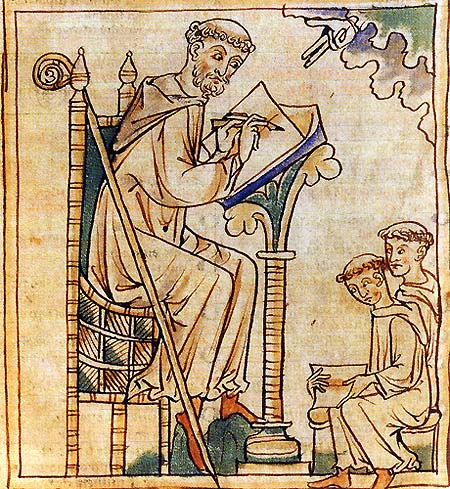“The way is humility, the goal is truth. The first is the labor, the second the reward” (p.29). These evocative words of St. Bernard from his treatise, The Steps of Humility and Pride, offer us a picture of what the monastic is to be about in the ‘school of the Lord’s service’. Encompassing the learning and the labor involved in this daily walk of humility and truth is Jesus, whose Voice continually reminds us: “I am the Way, the Truth, and the Life” (Jn 14:6). We are graced with this paradigm, this pattern, and so we are met each step of the way by the presence of Mercy, Christ. St. Bernard was clear about Christ’s presence in this process; he thus proceeds to translate for us through Christ’s life what is involved in the way (humility) and how the goal (truth) unfolds through the ground of humility.
So if any of us thinks this path is too difficult here is how Bernard responds: “Supposing, then, that you go on to object: ‘I see the way—humility; I long for the goal to which it leads—truth; but what if the way is so difficult that I can never reach the goal?’ The answer comes promptly: ‘I am the life,’ that is, I am the food, the viaticum, to sustain you on your journey” (p.29-30). Ok, so there is no excuse for anyone of us if we have just an ounce of faith!
Before Bernard goes into his main topic: which is, interfacing the steps of pride with the steps of humility, he speaks of three degrees “in the perception of truth” (p.34): “We must look for truth in ourselves; in our neighbors; in itself. We look for truth in ourselves when we judge ourselves; in our neighbors when we have sympathy for their sufferings; in itself when we contemplate it with a clean heart” (p.34). After stating what these three degrees of truth are, Bernard says that it is important to notice the order of these three degrees. Why is the order so important? He says: “For just as pure truth is seen only by the pure of heart, so also a brother’s miseries are truly experienced only by one who has misery in his own heart. You will never have real mercy for the failings of another until you know and realize that you have the same failings in your soul” (p.35). So sure enough we have to first begin by looking for truth in ourselves. When we are so negative towards a sister’s failings and cannot find a trace of mercy in our heart for her, what is that telling us? We are being called to return to our hearts and to look first for truth in ourselves. As we look for truth in ourselves are we finding the burn of jealousy, or an insistence on having to be right, or a defensive posturing? To learn about truth in our selves is the on-going work of self-knowledge. Another way Bernard will express it is that we are “learning mercy” (p.40). He tells us that Christ learned mercy, “the mercy that springs from sharing in our misery” (p.40). To repeat: we are to learn mercy and we have Jesus who is the icon of mercy to teach us; and one essential way that we learn mercy is when we look for truth in ourselves, and see that we have similar failings as our sister or brother.
In his book, Living In Truth, Michael Casey says that humility, as Bernard described it, is based on truth: “within oneself, in one’s relations with others, and with regard to God” (p.17). The parallel reality to humility is pride and Michael Casey points out that pride is more than inflation, “it is radical falsehood” (p.17). He says that in the ancient world truth was understood to mean “a quality of being” and that “truth touched not only the mind but also the heart and the emotions” (p.17). To understand truth ‘as a quality of being’ I think gives us a fresh approach or understanding of what Bernard means by ‘truth’. Also, that truth is not just a concept of the mind but it includes the heart and our emotions. Perhaps we could describe the first degree of truth as looking at the quality of my living, and of my authenticity.
To return to Bernard, he writes: “If a person wants to know the full truth about himself he will have to get rid of the beam of pride which blocks out the light from his eye, and then set up in his heart a ladder of humility so that he can search into himself” (p.43). Bernard says that when a person has seen “the truth about herself” or “when she sees herself in truth” she has come to have a “deep heart” (The Steps of Humility and Pride, p.43). The way: humility accompanied with the work of self-knowledge, leads to truth, a quality of being, a deep heart, a heart that knows mercy because it knows its own wounds, wounds that when they are not faced lead to sin, to blindness, to deceit, to hurting others and so on. The Steps of Humility and Pride was Bernard’s first work. But we can see how the themes in this work reappear in later works. For example, we had at mid-day prayer this pithy reading from On Precept and Dispensation: “I believe two things are necessary for the interior eye to be truly simple: love in intention and truth in choice….A person needs not only a warm and undeceiving heart but a keen and undeceived eye as well” (CF 1:36, p.133).
Humility is the way to truth: within our selves, in our relations with others, and with God. It transforms the heart and the interior eye helping us to live a quality of life that is evermore Christ like.
Holy Thursday
In John’s gospel Jesus bends down two times. The first is the scene with the woman caught in adultery (Jn 8:1-11). In this encounter with the upholders of the law


